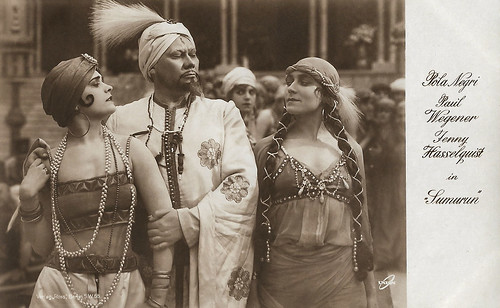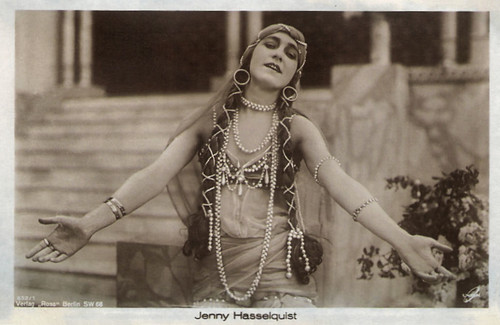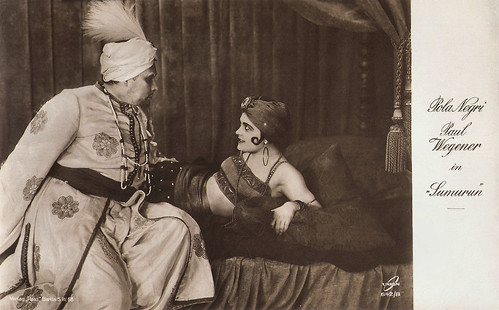Ernst Lubitsch's silent film Sumurun (1920) or One Arabian Night tells the exotic story of the favourite slave girl (Jenny Hasselquist) of a tyrannical sheik (Paul Wegener), who falls in love with a cloth merchant (Harry Liedtke). Meanwhile, a hunchback clown (Lubitsch himself) suffers unrequited love for a travelling dancer (Pola Negri) who wants to join the harem. The film was based on a pantomime by Friedrich Freksa, which Max Reinhardt had already staged and filmed successfully, a decade earlier.
![Pola Negri, Paul Wegener and Jenny Hasselquist in Sumurun (1920)]()
German postcard by Ross Verlag, Berlin. Photo: Union Film. Publicity still for Sumurun (Ernst Lubitsch, 1920) with Pola Negri,Paul Wegener and Jenny Hasselquist.
![Jenny Hasselqvist in Sumurun (1920)]()
German postcard by Ross Verlag, Berlin, no. 832/1, 1919-1924. Union Film. Publicity still for Sumurun (Ernst Lubitsch, 1920) with Jenny Hasselqvist aka Jenny Hasselquist as Sumurun.
![Pola Negri in Sumurun]()
German postcard by Ross Verlag, no. 642/1. Photo: Union-Film. Pola Negri and Jakob Tiedtke in Sumurun (Ernst Lubitsch, 1920).
A company of travelling performers arrive at a fictional oriental city. It includes the beautiful dancer Janaia (Pola Negri), the hunchback clown Yeggar (Ernst Lubitsch himself in his last leading film role) who is lovesick for Janaia and the Old Lady (Margarete Kupfer) who loves Yeggar.
The Slave Trader Achmed wants to sell Janaia to the Sheik for his harem. At the Palace, the Sheik (Paul Wegener) finds out that his favourite, Sumurun (Jenny Hasselquist), is in love with Nur al Din (Harry Liedtke), the handsome clothes merchant. He wants to condemn her to death but his son obtains her pardon.
After seeing Janaia dancing, the Sheik is keen to buy her. Yeggar is desperate and takes a magic pill which make him look dead. His body is hidden in a chest. The women from the harem come to Nur al Din's shop and hide him in a chest so that he can be brought into the Palace.
The chest containing Yeggar's body is also brought to the Palace and the Old Lady manages to revive him. The Sheik finds Janaia making love to his son (Carl Clewing) and kills both of them. He then finds Sumurun making love to Nur al Din and wants to kill them but he is stabbed in the back by Yeggar.
The filming of Sumurun began at the Ufa studios Union Berlin Tempelhof on 13 March 1920. The monumental sets were realised by Kurt Richter and Erno Metzner. The costumes were designed by Ali Hubert. Sumurun was classified by the Film Censor's Office as not suitable for minors. The première took place on 1 September 1920 in the Ufa-Palast am Zoo in Berlin
The German critics praised Sumurun highly. It was described as "a cinematic journey into a universe of emotions and passions of great intensity and utter perfection, with a remarkable Ernst Lubitsch in one of the main roles."
In the US, The New-York Times wrote that Sumurun gave added evidence that Ernst Lubitsch "is the superior of most directors anywhere, and that Pola Negri,, a Polish-German actress, is one of the few real players of the screen who can make a character live and be something other than an actress playing a part." The New-York Times concluded that, despite some shortcomings, it remained one of the year's best pictures.
![Sumurun]()
German postcard by Ross Verlag, Berlin, no. 642/2, 1919-1924. Union Film. Publicity still for Sumurun (Ernst Lubitsch, 1920) with Jenny Hasselquist and Aud Egede Nissen. Collection: Didier Hanson.
![Pola Negri in Sumurun (1920)]()
German postcard by Ross Verlag, Berlin, no. 642/5. Photo: Union Film. Pola Negri in Sumurun (Ernst Lubitsch, 1920).
![Sumurun]()
German postcard by Ross Verlag, Berlin, no. 642/7. Photo: Union Film. Publicity still for Sumurun (Ernst Lubitsch, 1920) with Pola Negri. Collection: Didier Hanson.
German postcard by Ross Verlag, no. 642/8. Photo: Union-Film. Pola Negri and Paul Wegener in Sumurun (Ernst Lubitsch, 1920).
The postcards here below were made for earlier versions of Sumurun. But which one? On the first postcard we could recognise at right Richard Grossman as the old woman. But who is the man left, 'Henrick'?
According to IMDb, Richard Grossman played 'Die alte' (the old woman) in Max Reinhardt's first film, Sumurun (1910), based on a pantomime by Friedrich Freksa. But IMDb does not mention a cast member called 'Henrick' for this silent film, produced by Deutsche Bioscope GmbH (Berlin)
So,perhaps this photo made for Max Reinhardt's stage production of Sumurun (1909)? In Krenn's Berlin-Chronik 1900 bis 1918, several stage members are mentioned in an article on the Berlin premiere (24 April 1910) of the stage production at the Kammerspielen de Deutsches Theaters. The article mentions that the production was a popular success and there had been already 74 performances.
Grete Wiesenthal played the lead as Sumurun and she would repeat her role in the 1910 film version. Leopoldine Konstantin played the dancer, both on stage as in the 1910 film. However, of the four main male actors - Alexander Moissi(as Nur Al Din), Rudolf Schildkraut, Paul Wegener (as the old Sheik) and Eduard von Winterstein (as his son) - only Von Winterstein returned in Reinhardt's film version, but now in the role of the old Sheik.
And Paul Wegener would return as the old Sheik in the 1920 film version of Sumurun by Ernst Lubitsch. But there's no mention of Henrick, so we still don't know for sure for which Sumurun production this postcard was made.
![Henrick and Richard Grossmann in Sumurun]()
German postcard by Photo und Kunstverlag Jos. Paul Böhm, München, no. 3061. Photo: publicity still for Sumurun (Max Reinhardt, 1910)?
![Leopoldine Konstantin in Sumurûn (1910)]()
German postcard by Verlag Hermann Leiser, no. 4310. Photo: Becker & Maass. Collection: Didier Hanson.
Leopoldine Konstantin in the 1909 stage production of the exotic dance pantomime Sumurun by Max Reinhardt. Konstantin also made her first film appearance in Max Reinhardt’s early silent film version Sumurun (1910), featuring Bertha Wiesenthal.
![Pola Negri in Sumurun (1913)]()
Polish postcard. Photo: publicity still for the play Sumurun. Collection: Marlene Pilaete.
From 1913 on, Pola Negri was a company member of the National Theatre of Warsaw. Her first big break there was her role of the dancer in the Pantomime Sumurun. A year later, she made her first Polish film, and in 1917 she moved to Berlin to make her German film debut. There Ernst Lubitsch made her a star and directed her in his film version of Sumurun (1920). Again she played the role of the dancer.
Sources: Wikipedia and IMDb.

German postcard by Ross Verlag, Berlin. Photo: Union Film. Publicity still for Sumurun (Ernst Lubitsch, 1920) with Pola Negri,Paul Wegener and Jenny Hasselquist.

German postcard by Ross Verlag, Berlin, no. 832/1, 1919-1924. Union Film. Publicity still for Sumurun (Ernst Lubitsch, 1920) with Jenny Hasselqvist aka Jenny Hasselquist as Sumurun.

German postcard by Ross Verlag, no. 642/1. Photo: Union-Film. Pola Negri and Jakob Tiedtke in Sumurun (Ernst Lubitsch, 1920).
A Journey into a universe of emotions and passions
A company of travelling performers arrive at a fictional oriental city. It includes the beautiful dancer Janaia (Pola Negri), the hunchback clown Yeggar (Ernst Lubitsch himself in his last leading film role) who is lovesick for Janaia and the Old Lady (Margarete Kupfer) who loves Yeggar.
The Slave Trader Achmed wants to sell Janaia to the Sheik for his harem. At the Palace, the Sheik (Paul Wegener) finds out that his favourite, Sumurun (Jenny Hasselquist), is in love with Nur al Din (Harry Liedtke), the handsome clothes merchant. He wants to condemn her to death but his son obtains her pardon.
After seeing Janaia dancing, the Sheik is keen to buy her. Yeggar is desperate and takes a magic pill which make him look dead. His body is hidden in a chest. The women from the harem come to Nur al Din's shop and hide him in a chest so that he can be brought into the Palace.
The chest containing Yeggar's body is also brought to the Palace and the Old Lady manages to revive him. The Sheik finds Janaia making love to his son (Carl Clewing) and kills both of them. He then finds Sumurun making love to Nur al Din and wants to kill them but he is stabbed in the back by Yeggar.
The filming of Sumurun began at the Ufa studios Union Berlin Tempelhof on 13 March 1920. The monumental sets were realised by Kurt Richter and Erno Metzner. The costumes were designed by Ali Hubert. Sumurun was classified by the Film Censor's Office as not suitable for minors. The première took place on 1 September 1920 in the Ufa-Palast am Zoo in Berlin
The German critics praised Sumurun highly. It was described as "a cinematic journey into a universe of emotions and passions of great intensity and utter perfection, with a remarkable Ernst Lubitsch in one of the main roles."
In the US, The New-York Times wrote that Sumurun gave added evidence that Ernst Lubitsch "is the superior of most directors anywhere, and that Pola Negri,, a Polish-German actress, is one of the few real players of the screen who can make a character live and be something other than an actress playing a part." The New-York Times concluded that, despite some shortcomings, it remained one of the year's best pictures.

German postcard by Ross Verlag, Berlin, no. 642/2, 1919-1924. Union Film. Publicity still for Sumurun (Ernst Lubitsch, 1920) with Jenny Hasselquist and Aud Egede Nissen. Collection: Didier Hanson.

German postcard by Ross Verlag, Berlin, no. 642/5. Photo: Union Film. Pola Negri in Sumurun (Ernst Lubitsch, 1920).

German postcard by Ross Verlag, Berlin, no. 642/7. Photo: Union Film. Publicity still for Sumurun (Ernst Lubitsch, 1920) with Pola Negri. Collection: Didier Hanson.
German postcard by Ross Verlag, no. 642/8. Photo: Union-Film. Pola Negri and Paul Wegener in Sumurun (Ernst Lubitsch, 1920).
Who is Henrick?
The postcards here below were made for earlier versions of Sumurun. But which one? On the first postcard we could recognise at right Richard Grossman as the old woman. But who is the man left, 'Henrick'?
According to IMDb, Richard Grossman played 'Die alte' (the old woman) in Max Reinhardt's first film, Sumurun (1910), based on a pantomime by Friedrich Freksa. But IMDb does not mention a cast member called 'Henrick' for this silent film, produced by Deutsche Bioscope GmbH (Berlin)
So,perhaps this photo made for Max Reinhardt's stage production of Sumurun (1909)? In Krenn's Berlin-Chronik 1900 bis 1918, several stage members are mentioned in an article on the Berlin premiere (24 April 1910) of the stage production at the Kammerspielen de Deutsches Theaters. The article mentions that the production was a popular success and there had been already 74 performances.
Grete Wiesenthal played the lead as Sumurun and she would repeat her role in the 1910 film version. Leopoldine Konstantin played the dancer, both on stage as in the 1910 film. However, of the four main male actors - Alexander Moissi(as Nur Al Din), Rudolf Schildkraut, Paul Wegener (as the old Sheik) and Eduard von Winterstein (as his son) - only Von Winterstein returned in Reinhardt's film version, but now in the role of the old Sheik.
And Paul Wegener would return as the old Sheik in the 1920 film version of Sumurun by Ernst Lubitsch. But there's no mention of Henrick, so we still don't know for sure for which Sumurun production this postcard was made.

German postcard by Photo und Kunstverlag Jos. Paul Böhm, München, no. 3061. Photo: publicity still for Sumurun (Max Reinhardt, 1910)?

German postcard by Verlag Hermann Leiser, no. 4310. Photo: Becker & Maass. Collection: Didier Hanson.
Leopoldine Konstantin in the 1909 stage production of the exotic dance pantomime Sumurun by Max Reinhardt. Konstantin also made her first film appearance in Max Reinhardt’s early silent film version Sumurun (1910), featuring Bertha Wiesenthal.

Polish postcard. Photo: publicity still for the play Sumurun. Collection: Marlene Pilaete.
From 1913 on, Pola Negri was a company member of the National Theatre of Warsaw. Her first big break there was her role of the dancer in the Pantomime Sumurun. A year later, she made her first Polish film, and in 1917 she moved to Berlin to make her German film debut. There Ernst Lubitsch made her a star and directed her in his film version of Sumurun (1920). Again she played the role of the dancer.
Sources: Wikipedia and IMDb.
